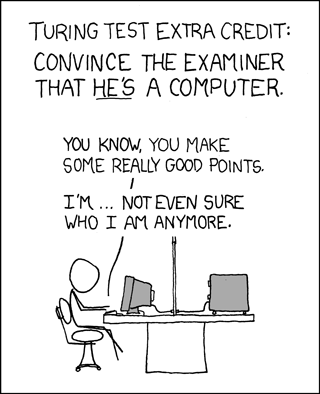Difference between revisions of "329: Turing Test"
(→Explanation: grammatical cleanup; minor link edits) |
(Changed wiki links, added CAPTCHA section.) |
||
| Line 9: | Line 9: | ||
== Explanation == | == Explanation == | ||
| − | In brief, a | + | In brief, a {{w|Turing test}} is a test for assessing whether a machine/program demonstrates "intelligent" behaviour. Suggested by {{w|Alan Turing}}, the test involves a human examiner talking through a computer terminal to either a human or a computer -- which it is, is not known to the examiner. If the machine/program's responses convince the examiner that he/she is talking to a human, the machine/program is said to be passing the test. This comic suggests that extra credit should be awarded if the machine/program is capable of "counter-convincing" the examiner that he's actually a computer. |
| + | |||
| + | The most common implementation of a Turing test Internet users may see is the {{w|CAPTCHA}} (Completely Automated Program to Tell Computers and Humans Apart), which is often found on web site registration pages and usually involves trying to identify letters/numbers in an image. The text in the image is often distorted and/or in different colors or sizes or fonts, or may be very blurry as if from a very bad photocopy. This is to deter an automated {{w|Optical_character_recognition|OCR}}(Optical Character Recognition) program from easily identifying the characters. The idea is that humans can process and decipher things from highly distorted pictures much easier than (current) computer algorithms can. | ||
| + | |||
| + | The title text may be hinting at an audio "CAPTCHA" to disambiguate "Test Tees" and "testes". | ||
== Transcript == | == Transcript == | ||
Revision as of 21:49, 24 August 2012
| Turing Test |
 Title text: Hit Turing right in the test-tees |
Explanation
In brief, a Turing test is a test for assessing whether a machine/program demonstrates "intelligent" behaviour. Suggested by Alan Turing, the test involves a human examiner talking through a computer terminal to either a human or a computer -- which it is, is not known to the examiner. If the machine/program's responses convince the examiner that he/she is talking to a human, the machine/program is said to be passing the test. This comic suggests that extra credit should be awarded if the machine/program is capable of "counter-convincing" the examiner that he's actually a computer.
The most common implementation of a Turing test Internet users may see is the CAPTCHA (Completely Automated Program to Tell Computers and Humans Apart), which is often found on web site registration pages and usually involves trying to identify letters/numbers in an image. The text in the image is often distorted and/or in different colors or sizes or fonts, or may be very blurry as if from a very bad photocopy. This is to deter an automated OCR(Optical Character Recognition) program from easily identifying the characters. The idea is that humans can process and decipher things from highly distorted pictures much easier than (current) computer algorithms can.
The title text may be hinting at an audio "CAPTCHA" to disambiguate "Test Tees" and "testes".
Transcript
- Screen 1:
- Title:
- Turing test extra credit:
- Convince the examiner that he's a computer.
- Examiner:
- You know, you make some really good points.
- I'm... not even sure who I am any more
Discussion
I think this is also a pretty obvious joke about Cleverbot, which constantly insists that you are a robot and it is a human. (See also 948: AI) 24.41.66.114 02:33, 16 September 2013 (UTC)
- I disagree, I think that's stretching it. Randall doesn't usually use others' punchlines wholesale, this seems like an original joke, and there are no references to Cleverbot to place the joke into that context. 108.162.249.155 03:39, 10 March 2016 (UTC)
Victorian era ended in 1901
Turing was convicted in 1952. 108.162.216.69 (talk) (please sign your comments with ~~~~)
The law was Victorian (1885), not the conviction. 23:52, 11 February 2015 (UTC)
"Chemical castration" simply reduces the libido - so hitting Turing in the testes would induce the same pain as in any other man.141.101.98.215 12:44, 21 May 2015 (UTC)
Shouldn't the description for the Turing test be changed to "demonstrate human-like behavior"? -- Flewk (talk) (please sign your comments with ~~~~)
